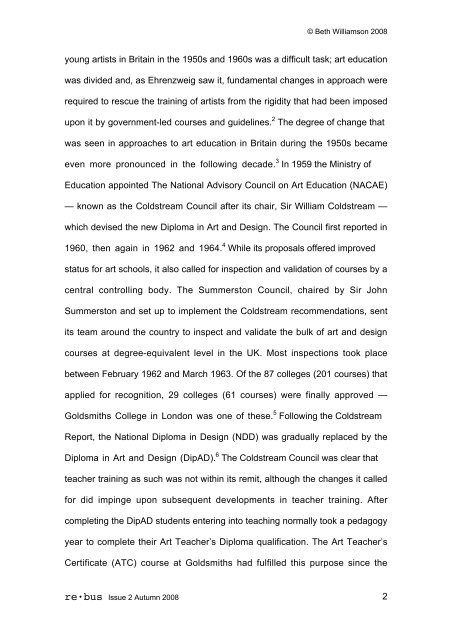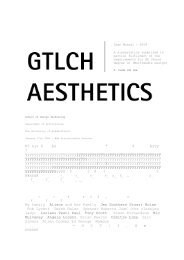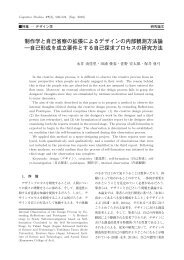Williamson
Williamson
Williamson
Create successful ePaper yourself
Turn your PDF publications into a flip-book with our unique Google optimized e-Paper software.
© Beth <strong>Williamson</strong> 2008<br />
young artists in Britain in the 1950s and 1960s was a difficult task; art education<br />
was divided and, as Ehrenzweig saw it, fundamental changes in approach were<br />
required to rescue the training of artists from the rigidity that had been imposed<br />
upon it by government-led courses and guidelines. 2 The degree of change that<br />
was seen in approaches to art education in Britain during the 1950s became<br />
even more pronounced in the following decade. 3 In 1959 the Ministry of<br />
Education appointed The National Advisory Council on Art Education (NACAE)<br />
— known as the Coldstream Council after its chair, Sir William Coldstream —<br />
which devised the new Diploma in Art and Design. The Council first reported in<br />
1960, then again in 1962 and 1964. 4 While its proposals offered improved<br />
status for art schools, it also called for inspection and validation of courses by a<br />
central controlling body. The Summerston Council, chaired by Sir John<br />
Summerston and set up to implement the Coldstream recommendations, sent<br />
its team around the country to inspect and validate the bulk of art and design<br />
courses at degree-equivalent level in the UK. Most inspections took place<br />
between February 1962 and March 1963. Of the 87 colleges (201 courses) that<br />
applied for recognition, 29 colleges (61 courses) were finally approved —<br />
Goldsmiths College in London was one of these. 5 Following the Coldstream<br />
Report, the National Diploma in Design (NDD) was gradually replaced by the<br />
Diploma in Art and Design (DipAD). 6 The Coldstream Council was clear that<br />
teacher training as such was not within its remit, although the changes it called<br />
for did impinge upon subsequent developments in teacher training. After<br />
completing the DipAD students entering into teaching normally took a pedagogy<br />
year to complete their Art Teacher’s Diploma qualification. The Art Teacher’s<br />
Certificate (ATC) course at Goldsmiths had fulfilled this purpose since the<br />
re·bus Issue 2 Autumn 2008 2





